The Shrines of Ise, in Japan
Tokio, November 6th, 1888
The old and the new of Japanese civilization may nowadays be seen in striking juxtaposition on the southern shore of the gulf of Owari.
From Kioto, a dozen hours of travel by railway and steamboat bring you to the little haven of Kamiyashiro, which does duty as the port of Yamada, head-quarters of the Shinto faith, and a goodly town of the province of Ise.
Then, as you step from the modern vessel's deck into an antiquated Japanese wherry, you have the comfortable conviction that you are escaping from the half-modernized world of new Japan, with its odd mixtures and incongruities, into the comparative peace and solitude of a region barely reached as yet by the waves of progress.
At Yamada itself, a couple of miles inland, this impression is rather confirmed than disturbed.
Old styles and old fashions are there supreme.
Except for a pillar letter-box here and there, or arrays of bottles in one or two shops dedicated to the Japanese liking for the bitter beer and light wines of the Occident, little of things new is to be seen.
Not a single building of foreign architecture intrudes upon the spirit of the place.
In its people, their dress and ways, in its bright shops, spacious inns, and numerous places of amusement, and in its narrow, picturesque thoroughfares - the houses all standing gable-wise to the street, and affording a delightful perspective of bold, fantastic, Oriental tiling, varied styles, deep eaves, and artistic proportions - the quaint old town remains even now pretty much what it was in the days of the Daimios.
Yamada, in fact, has not yet become the fashion.
Though habitually thronged with visitors, these are still, as of old, devout pilgrims to the altars of their faith.
Perhaps its position has saved it, for it is one of the outposts, in that quarter, of the Japanese Empire.
At all events, unlike Nikko, Ikao, Miyanoshita, and other polular resorts of holiday-makers, it is thus far free from the disintegrating influences of Western novelties and mobs of foreign tourists.
Few of the latter visit it.
Few, indeed, know its whereabouts, or have even heard of it.
Of course, hope to the contrary as we may, the present state of things will inevitably change, there as elsewhere, and all too soon.
But meantime Yamada continues to wear the "rust of antiquity".
There, if anywhere, you may put away from you for a while the Japan that is, and bask in tranquil enjoyment of life after the manner of the Japan that was.
Nor is the association with past times confined to matters temporal only.
It extends also to matters spiritual, and in a greater and much more far-reaching degree.
In Yamada and its neighbourhood you come face to face with the two most famous and hallowed shrines of the oldest religious systems in the world.
There are, it is true, a few other more ancient seats of worship elsewhere in Japan.
But these "two great divine palaces," as they are called, have been for ages the centre and stronghold of the early Shinto faith, and their history runs far back into the mists of time.
On the border of the town is the Geku, or outer palace, dating from the year 478 of our era.
The Naiku, or inner palace, three miles beyond, was established no fewer than 1,892 years age, and within it is hidden the original sacred mirror, said to have been forged out of metal from heavenly mines and bestowed by the Sun Goddess herself on her adoptd grandson, the founder of the Japanese Imperial dynasty.
Thus, year after year for nearly 19 centuries, Yamada has been visited by unnumbered hosts of the faithful and devout.
Chief of all holy places in the Empire, the Ise shrines are to the Shinto believers of this realm what Mecca is to the Moslems or Jeruasalem to the Christian Greeks.
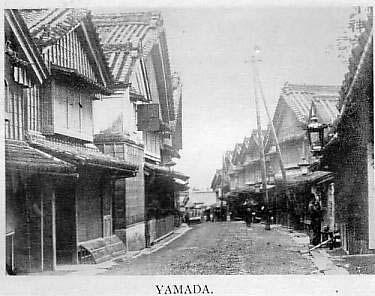
Shinto - the name given to the ancient religious belief of the Japanese, before Confusian philosophy and Buddhism came upon the scene - means "the way of the gods."
But it is a cult rather than a religion as commonly understood; its deities are for the most part terrestrial; and it had its roots in the remotest depths of Japanese mythology, which, as disinterred from old records and commentaries by the scholarly labours of Messrs.Satow and Chamberlain, may, for present purposes, be briefly outlined thus:-
In the beginning there were three great deities, who, by miraculous powers beyond man's ken, created "a Thing floated or suspended like a cloud in the midst of space, "without support or attachment.
In substance this mysterious Thing apparently embodied the materials of the solar system; and "the soil floated about, like a fish on the surface of the water."
Out of it were then created the sun and moon, and with them 14 gods, the last pair of whom, Izanagi and Izanami by name, separated the land from the water and gave birth to the Japanese islands.
Izanagi begat, among other offspring, Amaterasu, a female, and Susanowo, a male deity, whom he appointed respectively to rule the sun and moon.
Ohanomuji-no-mikoto, a descendant of the Moon-god, became the first ruler and part-civilizer of Japan.
Then Amaterasu sought to set up her adopted son in his stead.
He, however, proposed to substitute his own son; and ultimately, after the failure of two embassies, Ohanomuji was induced by the pressure of a warlike expedition to abdicate in favour of the younger deity, Ninigi-no-mikoto, grandson by adoption of Amaterasu.
From Ninigi, otherwise called the "sublime grand-child," was descended, in the third generation, Jimmu Tenno, the sovereign from whose reign Japanese chronology is reckoned, and in whose person began, more than 20 centuries ago, the long line of Japanese monarchs known to the world by the title of Mikado, but to their own people, and more correctly, by that of Tenshi, or Son of Heaven.
When the Sun-Goddess proclaimed Ninigi-no-mikoto supreme lord of Japan she delivered to him "the way of the gods" as established and imparted to her by Izanagi and Izanami; and she decreed that his dynasty should be immovable, and that his descendents should continue to rule the land of her birth as long as the sun and moon should endure.
Then, before dismissing him to his earthly kingdom, she bestowed on him the three sacred emblematic regalia, the mirror, sword, and stone, saying as to the first, "Look upon this mirror as my spirit, keep it in the same house and on the same floor with yourself, and worship it as if you were worshipping my actual presence."
For generations this injunction was stricly fulfilled.
But in the year 92 B.C. the reigning Tenshi, led to believe that the mirror's retention in his palace no longer had divine approval, removed it to a shrine specially erected for it in Yamato.
Thence, after several changes from place to place, it was eventually brought, in the year 4 B.C.to the new Naiku shrine, built for the purpose, where it remains to this day.
As the leading precepts of his terrestrial rule, Ninigi-no-mikoto was charged to love, while exacting strict obedience, from his people, and especially to worship and pray to the gods, beseeching favours from all, and propitiating those of them who had the power to harm.
"And," writes Hirata, the commentator, "as it is the duty of subjects to imitate the practice of the incarnate god who is their sovereign, the necessity of worshipping his ancestors and the gods, from whom they spring is to be enjoined upon every man."
In the above short and plain maxim are summed up the chief canons and articles of the Shinto cult.
Worship of the deities; implicit obedience to an infallible and god-descended monarch - these constitute the main fabric of the system, which, after all, is virtually a form of nature-worship.
Through it runs a strong vein of patriotism, as well as that deep reverence for the dead which in the Orient takes the shape of the general worship of ancestors.
But of moral code, strictly speaking, there is none.
Moral codes, it was said of old, might be well enough for immoral people; but the Japanese were akin to and enjoyed the special favour of the gods, and therefore needed no vain creeds or doctrines.
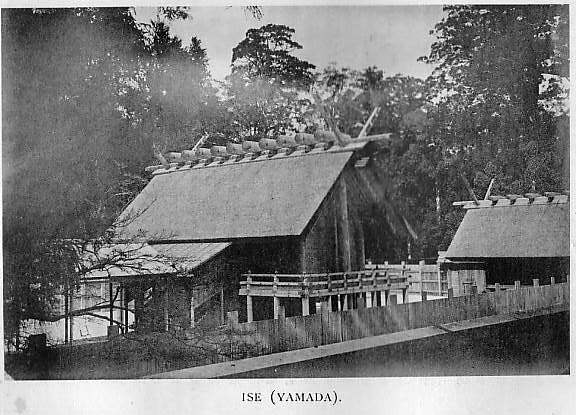

Simple and unadorned as the Shinto faith itself, and exhaling a like odour of antiquity, are the "two great divine palaces" of Ise.
He who may think to see in them any repetition of the architectural and decorative glories which distinguish the famed Buddhist temples at Nikko and Shiba will assuredly be disappointed.
At the Geku and Naiku you find no such splendour - no wealth of colour, ornaments or carving, no elaborate gateways or gorgeous altars, no pompous ceremonials, no images or objects exposed for veneration, no grandeur of form or cunning workmanship, no sacrifices, hardly any symbols.
On the contrary, there reigns supreme in every detail the rigid, almost rude simplicity of the purest and humblest Shinto style.
Except that the main posts are supported on hewn-stone blocks instead of entering the ground, that the floors are raised, and that wooden walls have taken the place of mats, the buildings approximate in form and structure to the primeval Japansese hut.
Wood and thatch form the materials; brass, bronze, and iron, scantily used, the sole adornments; plain fences of posts, rails and palisades the outer and inner cathedral enclosures.
There is no patch of paint or scrap of carving - no colour but the browns and drabs of thatch and weather-worn woodwork.
For gateways there are merely open torii, constructed of bare round logs, in the form with which the world is now familiar; for gates nought but hanging screens of thin white silk; for sacrifices daily offerings of water, rice, fish, salt, and other simple products of the land and sea.
The very lamps for the service of the temple are of coarse white paper, decorated only in black, with the chrysanthemum flower which is the crest of the Son of Heaven.
And in place of the long ranks of costly and beautiful toro, or lantern-standards, in stone and bronze, which line the approaches to more pretentious shrines, the few of such objects that are to be seen here are of common forms, common wood, and insignificant value.
As for emblems, they too are of the same simple and unaffected type.
Rice-straw ropes and wisps, sprigs and wands of the rare and sacred sakaki tree (cleyera japonica), hanging slips of notched white paper - each symbolical of some incident in the well-known legend of the Sun-goddess's enticement out of the cave to which she had retired, in wrath and pain, from the Moon-god's violence - that is all.
Though the sacred mirror and its copies are there too, they are never now seen by human eyes.
For each there is a spruce-wood box, shrouded in a wrapper of plain white silk and covered by a wooden cage, which again is completely hidden under a voluminous silken mantle.
Within the box reposes the mirror, in a sack of brocade, or rather in a succession of sacks, for, as soon as one begins to perish from age, a new one is added without removing it.
Of public ritual at these shrines there is virtually none, except on occasional feast-days; and even then it is of the most unpretending kind.
No sacerdotal hosts or gorgeous vestments, no incense or solemn music, no rites of adoration, no scriptures, sacrament, sermon, or blessing - none but two or three plain-robed priests, who, calling the deity's attention by strokes upon a gong, recite short prayers and formulas for a few minutes' worship, bow the head, and retire.
Now and then the kagura - a maiden dance of great antiquity, and said to be emblematic of the goddess Uzume's choragic feats before the cave of Amaterasu-is performed in a building outside of the temple; but it is not a feature of the ritual proper.
And the lay-worshippers; what of them?
Again the same tale of profound simplicity.
First purified by washing their hands in the neighbouring river, they advance to the silk screen at the fourth torii, cast a few coppers into the receptacle for tribute, clap their hands twice together, and then, with bowed heads and bended knees, or in a kneeling posture, remain for a minute or so, in silent or muttered prayer.
Petitions for posperity and long life, for correction of faults, and exemption from evil, sin, calamity, and pestilence-these, with humble expressions of worship, all in the fewest possible words, form the Shinto believer's prayer.
Long supplications after the way of the Scribes and Pharisees are no more favoured here than they were in Jerusalem, some 18 centuries ago, by the great founder of the Christian faith.
Brevity, indeed, was enjoined upon the people by ancient Shinto precepts.
The Son of Heaven's daily prayers for his subjects are, they were told, far more efficatious than the greedy petitions of individuals.
As for the neatness and cleanliness of the temples and their surroundings, these are beyond reproach.
Seen as I saw them but a little while ago, the roofs of the buildings at first seemed to almost wear the appearance of neglect.
The thatch had a seedy and withered look, and in some cases was overrun by creepers, or showed grasses and infant bushes springing up from its surface.
But you soon learn that this apparent neglect is studied.
Heat and cold, sun and rain, moss, lichen, and natural decay are purposely allowed to work their own will on the buildings and fences.
Beyond that, all is scrupulously cared for by tender and reverent hands.
Not a thing is out of place; not a weed disfigures the wide walks and gravelled spaces; not a scrap of dirt of any kind is where dirt ought not to be.
Let it not be supposed, however, that the buildings themselves are of great age, or even as old as they often look.
Those now standing were erected no longer ago than 1869.
But in this damp and highly variable climate a single decade goes far to impair rude thatch and unpainted cedar.
As a matter of fact, the entire structure of each temple is, and has been from time immemoril, renewed every 20th year.
Not by pulling down one set and building another in its place, but by the expedient of two precisely similar sites, contiguous to one another and alternately occupied, so that the old set is not demolished until the new one is ready.
The great point is the care that is taken to preserve the ancient style most faithfully in every detail.
Each successive structure is an exact copy of the last - exact to Oriental fidelity - and you know that, in looking on any one of them, you are beholding a genuine type of the identical buildings that prevailed in Japan before the birth of Christ.
Such, in their history and impressive plainness - which have surely left some marks, when you come to think of it, on the annals and temperament of the Japanese race - are the leading externals and other characteristics of the "two great divine palaces" of the Shinto faith.
These teach us that antiquity, simplicity and purity are the key-notes of Shinto in all its phases, as far as exemplified at its head-quarters in Ise.
Could any loftier ideals be devised for fostering those genuine and soul-stirring emotions which are aimed at in the fabrics of all religions?
I doubt it.
And I am sure that no man or woman, Christian or otherwise, can come away from Yamada without feeling that a very curious and deep interest attaches itself to those strange groups of homely buildings, breathing the flavour of age, decay, and repose, and bringing you into touch with the earliest days of the oldest faith of this interesting people.
As for the setting, it is well worthy of the gems.
If the Princess of old who chose the Ise sites can hardly be credited with having shown an equal taste for the grand and picturesque in nature to that, for example, which hit upon the mighty mansions of the Nikko mountains as the last resting-places of the early Tokugawa Shogun, at least the loving care of later generations of men has provided ample atonement for her shortcomings.
Nothing could better heighten the impression produced upon all beholders by the shrines themselves than the solemn magnificence of the forest groves and aisles by which they are surrounded and approached.
Evidently these were planted for the purpose - who shall say how many centuries ago?
Splendid, at all events, in form and dimensions, are the dense ranks of Japanese cedar, spruce, elm, and other trees which now rear their dark masses to heights so great that the firmanent is almost shut out from view.
Except where some giant has been ruthlessly beheaded by the typhoon's fury, these lordly forests seem to defy alike destruction, decay, and death.
The Naiku grove is especially enchanting, and its trees - the finest, without doubt, in all Japan - are a rare and goodly spectacle.
Here the sombre stillness is pleasantly broken by the sight and sound of the clear waters of the Isuzu-gawa, spanned by rustic bridges and rushing gaily to the sea.
And, as you thread the grand and lonely glades, approaching the old-world shrine of the Sun-goddess, you feel that you have before you a temple within a temple, and that the outer of these, reared by the great architect Nature, is a very meet and noble tabernacle for the time-hallowed sanctuary within.
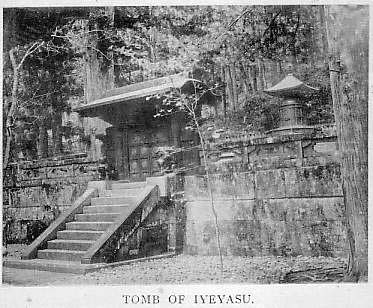
One would fain linger on at Yamada, especially in late autumn, when the forests put forth their glowing tints.
There is a something about the place, its people, its scenery, and associations, not to be lightly relinquished or easily forgotten.
But holidays have their limits, even as the columns of The Times - of which latter fact I feel at this moment guiltily and painfully conscious.
So we had to drag ourselves away one early morning, and be in turn-for we chose the land route - dragged along by flying, yelling jinrikisha-men, over the smooth and level high-road of Ise.
Past trim, prosperous towns and villages; past bands of white-clad pilgrims, robust, well-gaitered, and wayworn, with their bells and fans, fringed mats, and mighty hats of rush-straw; past running postmen, with letter-bags, instead of clothes; past squads of ruddy, old fashioned-looking school-lads, who bow politely, like the little gentlemen they are; past picturesque, thatched farmsteads, with high, neat fences, foxy dogs, and tailless cats; past torii and temples, embosomed in trees, but looking terribly out of repair; past lumbering coaches that might have come out of the Ark, with horses whose ancestors, we think ought not to have left it; past foot-travellers of many degrees - sturdy men, in white breeches and dark robes and gaiters, comely matrons, plump and panting and bronze-cheecked lasses, gay in scarlet kirtles and flower-decked coiffures; and then - surely the sweetest pedestrians of all - a pair of rosy children hardly out of infancy, reading their lessons aloud to themselves as they toddle home from school.
It is quite refreshing to see the pleased curiosity with which the whole population turns out to stare at us as we rush through the villages on our route.
Of the boys, the frisky contingent scream at us, run races with us, and blow at us through toy-trumpets, while those of a calculating turn of mind take to counting the jinrikishas and coolies on their fingers.
The girls are more amused than amazed.
They cover their mouths to hide their mirth, at length fairly exploding into laughter and scuttling away abashed at their innocent rudeness.
Then the country again.
On our left a wide expanse of highly cultivated but hedgeless fields, creeping far up the slopes of those distant, rugged, and fantastic ranges which bound the southward view.
On our right, very near, the dancing waters of the beautiful Owari Gulf, stretching away till lost in haze, and backed by the pearly silhouettes of the mountains of Mikawa.
Such is travel on the Ise-kaido in this twenty-first autumn of the Meiji era.
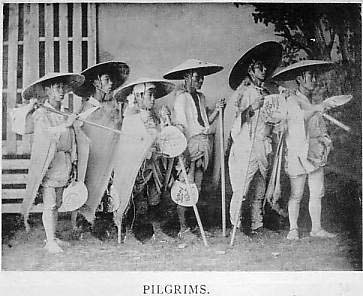
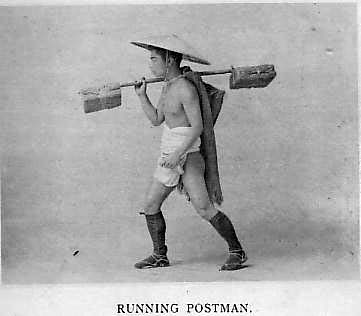
Next day the Tokaido-a more familiar and less pleasant road, hilly withal, and dusty.
Early in the afternoon we are at Otsu, which is lapped by the blue waters of Lake Biwa.
Our cheery jinrikisha-men have run their 83 miles since yesterday morning, an everyday affair which they take as a matter of course.
Then the train once more.
By sunset we glide into the station at Kioto; and thereafter, with a Japanese welcome from the smiling hostess at Nakamura's Hotel, our trip to Ise is ended, and we fully, almost sadly, realize that we have come back to the Japan of today.
The Times - Dec. 27th
Going Back to Article List
